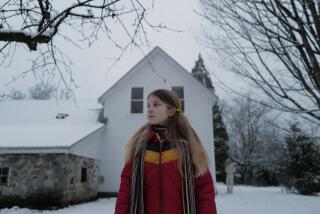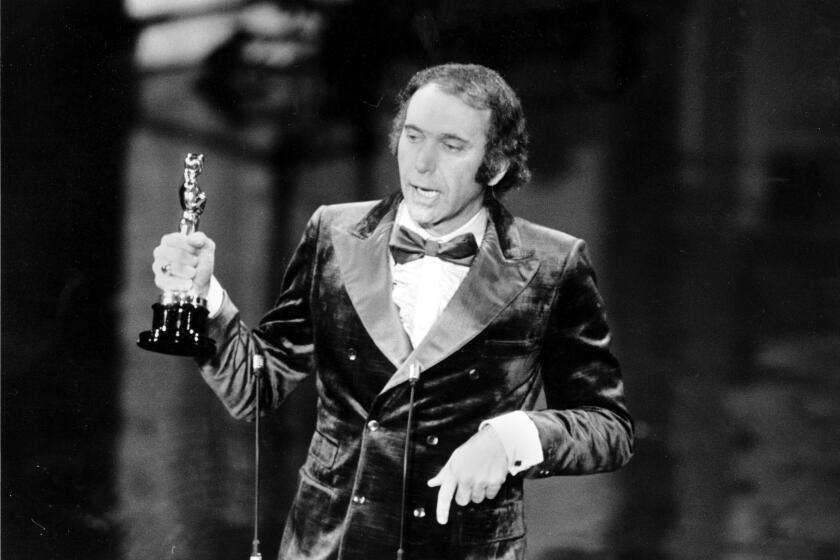The Three Faces of One’s Youth : The young actors who play author Frank McCourt in the adaptation of ‘Angela’s Ashes’ share a brotherly affection for one another.
When director Alan Parker set about adapting Frank McCourt’s best-selling novel “Angela’s Ashes” for film, he knew casting was going to be one of his major problems.
McCourt’s autobiographical book traces his childhood in poverty-stricken Ireland in the 1930s and ‘40s. It also deals with his alcoholic wastrel father Malachy (played by Robert Carlyle), his long-suffering mother Angela (Emily Watson) and the loss of three of his siblings in infancy. The story runs from McCourt’s early school days to his late teens, when he emigrated to New York.
“We were going to need three different boys to play Frank,” says Parker. So he set out to find a Young Frank (age 5 to 8), Middle Frank (age 8 to 13) and an adolescent Older Frank.
It turned out to be a massive search. Ros Hubbard, one of Parker’s three casting directors, had undertaken a similar mission for him in Ireland for his 1991 film “The Commitments,” about a group of Dublin kids who form a soul band. For “Angela,” she cast a wide net, organizing open casting calls in nine Irish cities, some of them advertised in Irish newspapers or by signs stuck on lampposts. Over a two-month period, 15,000 Irish boys submitted themselves to audition.
“We were fortunate to have so many to choose from,” Parker reflects now. “The age progression of the narrative meant we needed not only three Franks, but surrounding siblings and friends of different ages too.”
He also had to find three young Franks who could convince the audience that they are the same boy at different ages. Thus, they had to resemble each other in appearance and manner. The most unlikely discovery in the 15,000 applicants turned out to be Joe Breen, who plays Young Frank. He is a farmer’s son from County Wexford, south of Dublin, and his parents answered an ad in the Irish Times. On the day of his first audition, Breen, then 8 years old, awoke early, milked the cows on his father’s farm as he does every day, then made the two-hour journey to Dublin. He had never acted before in his life.
Parker, who calls Breen a “beautiful, unspoiled boy,” recalls fondly: “From his first day, he took effortlessly to his new career. Not only was he always word-perfect with his own lines, but often corrected the adults on theirs.”
Ciaran Owens, who landed the role of Middle Frank, had more acting experience. He is the youngest of five brothers; his brother Eamonn, 16, played the title role in Neil Jordan’s film “The Butcher Boy.” They have already appeared together in several Irish film and TV productions. “It was ironic that we should choose Ciaran after casting our net among so many newcomers,” Parker remarks.
Michael Legge, who plays Older Frank, also had TV and theater work on his resume. “He has great subtlety and application and, as with all good actors who make things look easy, there is a fierce intelligence at work,” Parker says of Legge.
“In many ways he has the hardest job, as he has to follow young Joe and Ciaran, who have the lion’s share of the film, dominating the first two acts. Cumulatively the two young ones are a hard act to follow.”
The three young actors agreed to be interviewed together about their filming experience; “Angela’s Ashes” was shot last fall in Ireland, mostly around Dublin, though partly in McCourt’s native city of Limerick. They reunited at a London hotel shortly after seeing a screening of “Angela’s Ashes.” The Paramount film opens in Los Angeles on Dec. 22.
They are different in looks and demeanor. Breen, now 9, is the cutup of the three--bright, irrepressible, charming and extremely funny. He can reduce the other two to helpless laughter. Owens, 13, is husky-voiced, polite and diplomatic, while Legge, 20, is shy and soft-spoken, but passionately articulate about the film.
The trio, who shared only one scene on camera but constantly bumped into one another on set, were affectionate with one another and generous about the others’ contributions, but an undercurrent of teasing permeated their conversation. Just like brothers, really.
*
Question: How did you hear about the roles?
Legge: My agent told me they were making “Angela’s Ashes,” and I should get down to Dublin to audition.
Owens: I was working on Anjelica Huston’s film “Agnes Browne” when we heard there were parts going for “Angela’s Ashes.” So my brother Eamonn and I went in to audition, but not for specific roles. It could have been that he’d have been up for Middle Frank, and I’d have tried for young Frank. Just as well it didn’t happen like that. I’d never have got the part over Joe.
Breen: Heh-heh!
Owens: As it turned out, Eamonn got a role too. He plays Frank’s friend Peter Dooley, who they call Quasimodo.
Breen: We read about an audition in the newspaper, and we traveled up to Dublin. Got up, milked the cows, headed off. Then Alan Parker asked me to come back again and read with him. Then again and again. It was three times in all, then I got the part.
*
Q: How was it working with Alan Parker?
Owens: He’s really nice.
Breen: Ah, but Ciaran, he can get awful hot-tempered at times!
*
Q: Alan got hot-tempered with you?
Breen: Yes [giggles].
*
Q: Why? Were you fooling around on set?
Breen: Yes [giggles some more]. But he was nice too. He was always making jokes.
Owens: He was really nice to us. And if we didn’t like the way a scene was going, he let us try it different ways. He was great like that.
Legge: It was just extraordinary to work with him. It was a long shoot and a tiring one, but the way he dealt with it was fantastic. Even if you had a 5 a.m. call, you were dying to get up and go off to work with him. That thing that Ciaran said about letting us do our own thing, it’s true. From the moment I got on set, the atmosphere was really good. Everyone was working so well together. If there was a difficult scene coming up, he’d always talk it through, make it easier.
*
Q: Alan Parker has worked a lot with kids and young people.
Breen: Yes, ever since he did “Bugsy Malone.” He showed us that film. And he told us the kids in “Bugsy” used to play tricks on him too!
*
Q: What was the best part about making the film?
Breen: The rain machines!
Legge: I was going to say that was the worst thing. Along with the water and the damp.
*
Q: It’s certainly a damp, chilly-looking film. Didn’t you all get colds or flu?
Breen: Not us.
Owens: There were doctors and nurses on set to take care of us. And people to wrap us up after a scene, keep us warm.
*
Q: So what was the hardest part of filming?
Breen: Having to finish it and go back to school.
Legge: Actually, the hardest part for me was having to be on a diet. I had to lose weight so I’d look a bit scrawny for the nude scene [Breen chuckles]. I lost two stone (28 pounds) eventually.
Breen: And we’d be having lunch together and I’d always be offering Michael a piece of me chicken, and he wasn’t allowed to eat it!
Legge: Yeah, thanks a lot, Joe.
Owens: It was hard having to wear contact lenses for those scenes when my eyes get sore from the coal dust [in the film, his eyes and eyelids look painfully bruised and barely able to open, with pink and red blotches]. They were really uncomfortable, though I know they were necessary for my eyes to look that bad. And they did look realistic.
*
Q: Did you have a favorite scene?
Owens: Jumping off a wall properly and landing without hurting yourself. I know that doesn’t sound like much in acting terms, but it was a good skill to learn.
*
Q: You all look a good match in the movie, but in real life, you don’t look at all alike.
Owens: Joe and I had to have our hair dyed to match Michael, whose hair at the time was dark, only a bit lighter than it is now. You won’t mind me saying that, Michael. And because he has freckles, Joe and I had to have freckles painted on too.
Breen: Bleeuuggh!
Legge: But then I had to have your chin, Ciaran.
Owens: Oh yes [points to a cleft in his chin]. Because I have this, the others had to have it too.
*
Q: Did you talk to Frank McCourt when he visited the set?
Legge: No. He arrived once when I was there, just a couple of minutes before I was about to start a scene. I had the chance to talk to him, and it wasn’t that I didn’t want to, but I thought at that moment it would distract me.
Breen: He came on set one day and Alan Parker pointed him out to me. He said, “Do you know who that is?” And I said, “That’s me but older.” But we didn’t talk.
*
Q: Did it seem amazing to you to think that the poverty portrayed in the film really existed in Ireland only 50 or 60 years ago?
Legge: It’s hard to believe, really.
Breen: It makes me think Mr. McCourt must have been very advanced.
*
Q: Why?
Breen: Well, he grew up poor and became successful. . . . And his mother and father didn’t make anything of themselves, did they?
*
Q: Have you all been working since the film?
Owens: I’m in two [BBC-TV] series, “Eureka Street” and “Ballykissangel.”
Legge: And I’m in a new British movie called “Whatever Happened to Harold Smith?” It’s directed by Peter Hewitt [“The Borrowers”]. And after “Angela’s Ashes,” I did a workshop at the National Theatre here in London for six months.
*
Q: Will you be acting again, Joe?
Breen: Yes, I hope so. I like making films!
*
Q & A with author Frank McCourt. Page 41
More to Read
Only good movies
Get the Indie Focus newsletter, Mark Olsen's weekly guide to the world of cinema.
You may occasionally receive promotional content from the Los Angeles Times.






